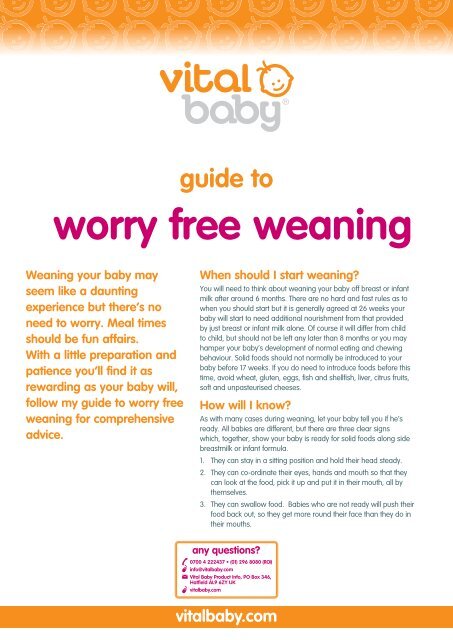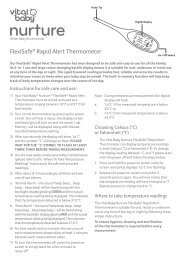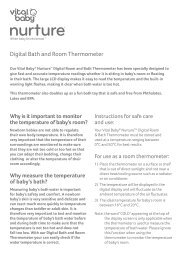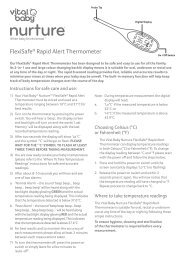Create successful ePaper yourself
Turn your PDF publications into a flip-book with our unique Google optimized e-Paper software.
guide to<br />
worry free weaning<br />
<strong>Weaning</strong> your baby may<br />
seem like a daunting<br />
experience but there’s no<br />
need to worry. Meal times<br />
should be fun affairs.<br />
With a little preparation and<br />
patience you’ll find it as<br />
rewarding as your baby will,<br />
follow my guide to worry free<br />
weaning for comprehensive<br />
advice.<br />
When should I start weaning?<br />
You will need to think about weaning your baby off breast or infant<br />
milk after around 6 months. There are no hard and fast rules as to<br />
when you should start but it is generally agreed at 26 weeks your<br />
baby will start to need additional nourishment from that provided<br />
by just breast or infant milk alone. Of course it will differ from child<br />
to child, but should not be left any later than 8 months or you may<br />
hamper your baby’s development of normal eating and chewing<br />
behaviour. Solid foods should not normally be introduced to your<br />
baby before 17 weeks. If you do need to introduce foods before this<br />
time, avoid wheat, gluten, eggs, fish and shellfish, liver, citrus fruits,<br />
soft and unpasteurised cheeses.<br />
How will I know?<br />
As with many cases during weaning, let your baby tell you if he’s<br />
ready. All babies are different, but there are three clear signs<br />
which, together, show your baby is ready for solid foods along side<br />
breastmilk or infant formula.<br />
1. They can stay in a sitting position and hold their head steady.<br />
2. They can co-ordinate their eyes, hands and mouth so that they<br />
can look at the food, pick it up and put it in their mouth, all by<br />
themselves.<br />
3. They can swallow food. Babies who are not ready will push their<br />
food back out, so they get more round their face than they do in<br />
their mouths.<br />
any questions?<br />
0700 4 222437 • (01) 296 8080 (ROI)<br />
info@vitalbaby.com<br />
<strong>Vital</strong> <strong>Baby</strong> Product Info, PO Box 346,<br />
Hatfield AL9 6ZY UK<br />
vitalbaby.com<br />
vitalbaby.com
Be patient<br />
<strong>Weaning</strong> is a great time to engage with your baby and<br />
many specialists feel it’s an important way to encourage a<br />
sense of well-being. Remember to be patient. <strong>Weaning</strong> is a<br />
slow process, your baby has to learn how to swallow and<br />
explore new textures and sensations. He may struggle to<br />
finish the food you give him but just like us grown ups, a<br />
baby’s appetite will vary from day to day. You should never<br />
need to force him to eat. Always let your baby guide you<br />
and develop at his own pace.<br />
Beginning the process<br />
By far the best food to start him on is baby rice. This is a<br />
gluten free product and specially formulated for babies.<br />
Mix the baby rice with your regular breast or infant milk until<br />
it reaches the consistency of single cream. Avoid introducing<br />
your baby to food when he’s either very tired, hungry or<br />
upset. Choose a meal time either at lunch or early evening<br />
and make sure you have plenty of time and no distractions.<br />
Any distress or anxiety on your part will be sensed by your<br />
baby. Make sure your baby is able to hold his head in an<br />
upright position whilst sitting propped up and you are both<br />
sitting comfortably.<br />
Always spoon feed your baby, never add food to his bottle.<br />
Remember you are trying to wean your baby off the bottle,<br />
it will also increase the risk he might choke. If your baby<br />
pushes the food out of his month or refuses it, don’t worry,<br />
he probably just isn’t quite ready yet, continue milk feeding<br />
and try again in a few days. During the early months of<br />
weaning, it’s important your baby still receives his daily<br />
portions of breast or infant milk, about 600ml. Your aim is to<br />
slowly replace the milk feeds with solid food meals. To start<br />
with, your baby only needs a taste of solid food then little<br />
by little, you can build his up his intake, but still give him his<br />
milk. Start by reducing the milk given at lunch time or mid<br />
afternoon and increasing the amount of baby rice. Once<br />
your baby is comfortable with the concept of solid food, you<br />
may want to start trying new foods with different textures<br />
and tastes.<br />
Worry Free <strong>Weaning</strong><br />
1. Choose the right time. A quiet relaxed moment when you<br />
and your baby will not be disturbed.<br />
2. Sterilise all baby feeding equipment - bowl and spoon.<br />
And wash you and your baby’s hands thoroughly before<br />
you start.<br />
3. Offer only a little on the spoon and gauge your baby’s<br />
reaction. You will only need to give your baby small<br />
portions. Offer verbal encouragement.<br />
4. Don’t push your baby to eat more than he wants. Don’t<br />
worry if he doesn’t eat much or anything at all. Let him go<br />
at his own pace.<br />
5. Over 6-8 weeks of weaning, increase the amount from just<br />
a taste in the first week up to eating solid food 3 times a<br />
day, but match your baby’s appetite. It’s important to keep<br />
feeding him breast or infant milk throughout this period.<br />
Lets have a look at a suggested menu plan:<br />
During first After weaning From about<br />
2 weeks of weaning for about 2 weeks 5 or 6 months<br />
Number of meals a day One Two Three<br />
Breakfast Breast or infant milk <strong>Baby</strong> rice mixed <strong>Baby</strong> rice mixed<br />
with breast or infant milk with breast or infant milk<br />
Midday Breast or infant milk Breast or infant milk Puree of meat or pulses<br />
and vegetables<br />
Early Evening <strong>Baby</strong> rice mixed with Fruit or vegetable puree Fruit puree and<br />
breast or infant milk and breast or infant milk breast or infant milk<br />
Late Evening Breast or infant milk Breast or infant milk Breast or infant milk
6. Thicken the consistency of the food and begin to combine<br />
different fruits or vegetables. Don’t be afraid to experiment<br />
with combinations.<br />
7. After 6 months introduce chunkier finely chopped foods<br />
to encourage chewing. Babies can chew even if their<br />
teeth haven’t come through. Introduce new concepts<br />
slowly by mixing small amounts of chunky food in with<br />
pureed food.<br />
Introduce:<br />
Citrus fruits - oranges, grapefruit and satsumas<br />
Eggs - well cooked with solid yolks<br />
Mild flavoured cheese<br />
Full-fat yoghurt and fromage frais<br />
Fish and meats, well mashed or minced<br />
Avoid:<br />
Any added sugar or salt, whole or broken nuts, honey<br />
8. Slowly increase the variety of foods, limiting cereals to<br />
once a day.<br />
Begin to add wheat products and foods that contain<br />
gluten, bread, pasta, breakfast cereal, foods made from<br />
wheat, oat, rye and barley.<br />
9. Always encourage your baby to try and feed himself.<br />
Let him put food in his hands, give him his own spoon<br />
to hold. It may be messy but it’ll help him grow more<br />
confident and make meals times more fun. Good food<br />
presentation will also help to make the experience more<br />
appealing to your baby.<br />
Menu plan for 6-9 months<br />
1. Choose the right time. A quiet relaxed moment when you<br />
and your baby will not be disturbed.<br />
2. Sterilise all baby feeding equipment - bowl and spoon.<br />
And wash you and your baby’s hands thoroughly before<br />
you start.<br />
3. Offer only a little on the spoon and gauge your baby’s<br />
reaction. You will only need to give your baby small<br />
portions. Offer verbal encouragement.<br />
4. Don’t push your baby to eat more than he wants. Don’t<br />
worry if he doesn’t eat much or anything at all. Let him go<br />
at his own pace.<br />
5. Over 6-8 weeks of weaning, increase the amount from just<br />
a taste in the first week up to eating solid food 3 times a<br />
day, but match your baby’s appetite. It’s important to keep<br />
feeding him breast or infant milk throughout this period.<br />
Lets have a look at a suggested menu plan:<br />
Day 1 Day 2 Day 3<br />
Breakfast <strong>Baby</strong> rice or cornmeal Wheat-based cereal Mashed banana and<br />
porridge (mixed with either (with breast or infant milk toast fingers<br />
breast or infant milk<br />
or whole milk)<br />
or whole milk)<br />
Midday Spaghetti Bolognese Minced lamb and Lentil and vegetable bake<br />
(chopped) vegetable casserole Semolina with<br />
Plain fromage frais with mashed potato strawberries<br />
with stewed apples Soft, ripe peeled pear or<br />
peach (as finger food)<br />
Early Evening Fish, broccoli Scambled egg with toast Macaroni cheese<br />
and mash potato<br />
Cooked carrot<br />
(as finger food)<br />
Late Evening Breast or infant milk Breast or infant milk Breast or infant milk
From 9-12 months your baby will probably be eating 3 meals<br />
and 2 or 3 snacks each day and may be ready to starting<br />
eating with you, as part of a family meal. Give your baby<br />
the same food as you, let him share in the experience. Do<br />
not season your baby’s food, separate it before adding<br />
additional salt, pepper or spices.<br />
Each day try to give your baby:<br />
• 3 or 4 servings of starchy foods like potato, pasta bread<br />
or rice<br />
• 3 or 4 servings of fruit and vegetables<br />
• 1 serving of meat, fish or egg<br />
• At least 2 servings of pulses such as peas, beans or lentils<br />
NEVER LEAVE YOUR BABY ALONE WHEN FEEDING<br />
Drinks<br />
As your baby begins to eat more food he will become more<br />
thirsty. Babies need water for growth so require a good<br />
fluid intake. Milk is high in calories and will fill your baby up<br />
so the best drinks to offer him are cooled, boiled water or<br />
watered down fruit juice. Avoid fruit cordials as these are<br />
loaded with sugars and preservatives. Try to avoid filling<br />
your child up with liquids before meal times. Offer him a<br />
drink after feeding and at about twice a day in between<br />
meals. Don’t with hold drinks however if your baby is thirsty.
Your questions answered<br />
What do I need to start weaning?<br />
Follow this as a suggested weaning kit:<br />
• Fork, masher, sieve and/or hand blender<br />
• Brightly coloured plastic bowls and spoons will make<br />
feeding time more fun. Choose ones with good grips<br />
• A bib: a sleeveless, easy to wipe clean one will be best<br />
• A baby chair, unless you are comfortable to sit the baby on<br />
your lap for the initial feedings<br />
• A high chair for when you need to sit your baby upright<br />
• <strong>Baby</strong> wipes<br />
• Storage tub or ice cube trays to store and freeze<br />
left over food<br />
Why does my baby gag when I feed him?<br />
There are many reasons why a baby will gag at food.<br />
Usually it’s just a question of technique. Make sure the food<br />
is not too thick. Don’t over load the spoon. Keep the portions<br />
small. Be sure you are not placing the spoon too far inside<br />
baby’s mouth. Gagging is also one way which your baby can<br />
tell you that he’s had enough, so if he’s gagging towards the<br />
end of a meal, he’s probably full up.<br />
Why does my baby have a poor<br />
appetite?<br />
A babies’ appetite may vary from day to day, just like<br />
our own. If his appetite is consistently small however, be<br />
sure you are not filling him up with milk feeds of drinks in<br />
between meals. If he’s still milk feeding, only offer it after<br />
solid foods, and regulate drinks through out the day. It might<br />
be that you baby is thirsty at meal times and a quick drink<br />
will help him to continue eating.<br />
My baby is teething what can I do<br />
to help?<br />
Offer him more chunky foods to encourage chewing or let<br />
him chew on fingers of toast, peeled banana, segments of<br />
cheese or soft vegetables like cooked carrot or green beans.<br />
Once your baby can hold them in his hands you can offer<br />
these as finger foods to snack on. To help ease some of<br />
the discomfort caused by growing teeth offer him pieces of<br />
apple or pear, these help to sooth the gums.<br />
When can I give my baby cow’s milk?<br />
You should avoid giving your baby cows milk as a drink<br />
before he is one year old. Though you can add cows milk to<br />
foods during cooking after 6 months. Always give your baby<br />
full fat milk as this will help with this development.<br />
How long should meal times take?<br />
Generally meal times shouldn’t last longer than 20 minutes.<br />
Babies tend to lose interest after this time. Take away the<br />
remaining food, don’t force you baby to finish it all, the<br />
chances are he will no longer be hungry.<br />
Is it best to buy food or make it myself?<br />
This is very much a question of choice and time! There<br />
are a good number of baby foods available to buy with<br />
varying ingredients and textures depending on what stage<br />
of weaning you are at. It is wise to have some bought food<br />
available at home in case of emergencies. Be careful not<br />
to freeze bought food in the jar, as the glass can shatter<br />
leaving shards in the food. Remember also to follow exactly<br />
the manufacturer’s reheating instructions. Some baby foods<br />
are designed to react with the enzymes in baby’s saliva<br />
helping to make the food become runnier and aid the child<br />
in swallowing. Therefore, it is important not to spoon feed<br />
your child straight from the jar, as this will spoil the food.<br />
Of course it’s preferable to make your own food, this way you<br />
know exactly what’s in it and you can tailor recipes to better<br />
suit your baby’s tastes. Just make sure all the equipment<br />
you use is clean and you always wash your hands before<br />
preparing any food. It’s recommended that you sterilise all<br />
bowls and spoons until your baby is 6 months. It’s more<br />
economical to make larger batches and freeze the left over<br />
food. Using ice cube trays is a great way to do this, the blocks<br />
are just the right size for a single portion. Date each batch and<br />
use within 3 months. Only ever reheat the food one.<br />
Can I reheat food in the microwave?<br />
Yes you can, but it’s not ideal. Often microwaves don’t heat<br />
food evenly ALWAYS stir the food and check the temperature<br />
before feeding it to your baby. Otherwise take the required<br />
amount of food and place it in a clean cup. Stand the cup in a<br />
pan of hot water, cover it with a saucer and leave it to warm<br />
through. Leave the food long enough to ensure that it’s hot<br />
all the way through and let it cool to the right temperature<br />
for your baby. Stir the food to get it an even temperature and<br />
remember to test it before feeding it to your baby.<br />
Should I hold my baby or put him<br />
in a chair?<br />
It is often a good idea to keep your baby close to you during<br />
the early stages of weaning until he gets used to being<br />
spoon-fed. You can put the baby on your knee, with his head<br />
resting against your shoulder. You can then hold his arm to<br />
stop him interfering. After a time you might find a high chair<br />
more useful as this will leave you with both hands free.






